Lecture
Neural networksAttempts were made to build artificial intelligence based on neural networks. Immediately, we note that for a full-fledged simulation, you should have a sufficient number of neurons, to ensure the potential complexity. On one neuron, it is clearly impossible to imitate intelligence. How many neurons are needed to create it? How does a real neuron function? |
Juice through the tree drives up the force of osmotic pressure. Osmosis is the force of spontaneous penetration of the solvent (water) into the solution (water with sugar) separated from it by a membrane (film, semipermeable membrane) through which the solvent passes but does not pass the dissolved substance. Examples of membranes in nature are - frog skin, bladder, clay. The membrane is characterized by conducting various substances through itself in various directions with different abilities. |
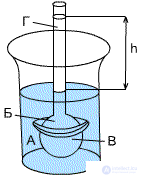 fig.10.1 The simplest osmometer: A is a vessel with a solvent, B is a tube with a solution, C is a semipermeable film (membrane), G is a scale for measuring the difference in levels h. |
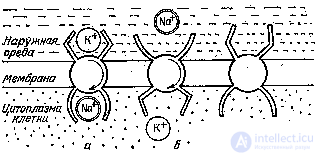 fig.10.2 The scheme of the sodium-potassium pump: a - the active centers captured potassium ion outside and sodium ion inside the cell; b - the protein molecule that captures the ions, turned 180 ° due to the energy of ATP and released the captured ions, while potassium got inside the cell, and the sodium ion was thrown out; c - the molecule again turned 180 ° and is ready to capture new ions. |
The device of a cellular membrane: consists of fat-like substance (lipids), 2 molecules thick with the built-in set of proteinaceous molecules. These molecules - ion channels (pumps) - pass some substances and do not pass others. Different protein inserts provide the effect of various "filters". Over time, the ion channels are destroyed and formed, they are continuously regenerated. The ribosome channels are synthesized under the control of RNA. Ion channels are probabilistic - at one point in time they can roll over (work) and let a substance into the cell, or they may not. Thus, nature is protected from shock loads. |
Diffusion in liquids occurs with the help of ions. Thus, the diffusion of charges. NaCl - salt solution in water. Ions have a different mass and therefore move in water at different speeds. Ion separation occurs — the Nernst potential arises. The cell has a surface charge. If the membrane is excited by an external source (20mB), then this membrane becomes more permeable to Na ions (20 times more). Na is substantially more in the environment - sodium current arises and the cell recharges (the charge instead of negatively becomes positive) and is in such a charged state. But due to the fact that Na becomes larger, then the cell ceases to distort Na from the medium. |
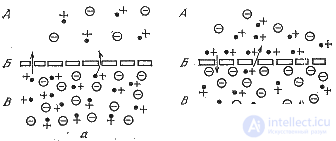 fig.10.3 The emergence of a potential difference on a semipermeable membrane: A - a solution with a low ion concentration (external environment), B - a semipermeable membrane that transmits positive kalin ions, but does not permeate anions, C - a solution with a high concentration of ions inside the cell, and - Initial state before the occurrence potential differences: inside potassium ions (black points) a lot, outside (solution A) - a little, but both there and there the charges of potassium ions are compensated by negative charges of anions, b - Final state of dynamic equilibrium: part of ion penetrated the potassium through the semipermeable membrane, outside the positive charges became more than the negative, inside - the opposite. The anions pull the "escaped" potassium ions back, as a result, the fluxes of potassium ions through the membrane in that and in the other direction become equal. The Nernst potential emerged. |
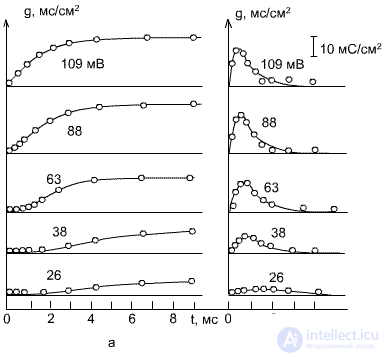 fig.10.4 Dependence of potassium (a) and sodium (b) conductivities of the cell membrane on time and on the magnitude of depolarization. The abscissa is the time in ms, and the ordinate is the membrane conductivity in mS / cm2. The numbers near the curves show the MP shift from the PCB towards zero or even further towards positive potentials. The points show the values obtained in the experiment, and the curves show the result of solving the Hodgkin-Huxley equations. |
Model 1 (Hodgkin-Huxley)This model describes the microdynamics of a neuron. |
|
The neuron conducts an electrical signal, but not like a metallic conductor. The movement of the excitation pulse occurs due to the fact that the previous front excites the next. |
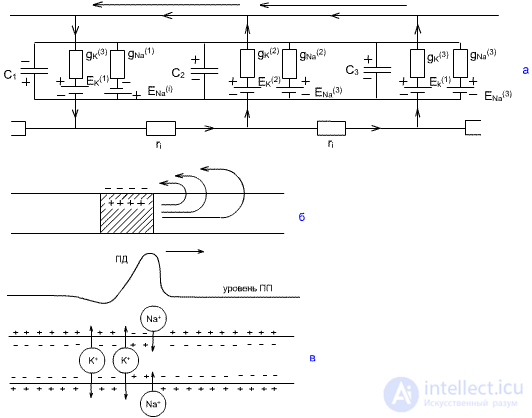 fig.10.5 Schemes explaining the mechanism of excitation propagation along the nerve fiber: a is the equivalent electrical circuit of the nerve fiber, section 1 is excited, capacitor C1 is recharged, current flows from C2 and from C3 to C1 (the current strength is indicated by the arrows), next time the capacitor recharges C2; b - an illustration of the theory of local Hermann currents; c - the spread of nerve impulses is associated with a change in the conductivity of the membrane: the leading front of the PD is caused by the flow of incoming sodium ions, and the posterior one by the output of potassium ions from the fiber. |
The spread of the pulse has its own characteristics. |
 The refractory period (the time during which the cell is immune to excitation) prevents the pulse from spreading in another direction. The refractory period (the time during which the cell is immune to excitation) prevents the pulse from spreading in another direction.  One randomly excited cell cannot excite neighboring cells - its charge is small, and the charges of neighboring cells are suppressed. One randomly excited cell cannot excite neighboring cells - its charge is small, and the charges of neighboring cells are suppressed.  The excitation front spontaneously straightens. The excitation front spontaneously straightens.  If the impulse encounters an obstacle, the front can begin to move in a spiral (pulse generator). If the impulse encounters an obstacle, the front can begin to move in a spiral (pulse generator). |
The constant rhythm of the body is provided by smoothing, averaging, refractoriness and self-synchronization of cell ensembles. |
Model 2The model is dynamic. |
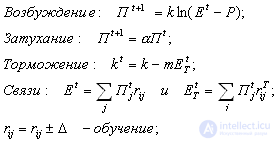 |
k is the excitation coefficient. Excitation, as can be seen from the formula, occurs only when the input potential E t exceeds the threshold value P. In the attenuation formula, the attenuation coefficient a is present. r ij - gain. If it increases, information is memorized. When its values decrease, the information is forgotten. |
Model 3 (discrete level)An element can perform various logical functions. A neuron is an element with reconfigurable logic. |
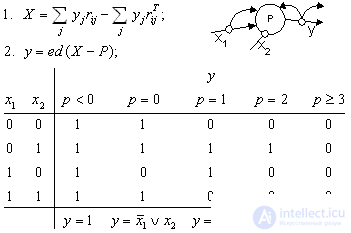 |
Model 4 (neural network model) |
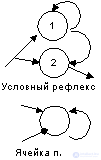 |
Comments
To leave a comment
Artificial Intelligence
Terms: Artificial Intelligence